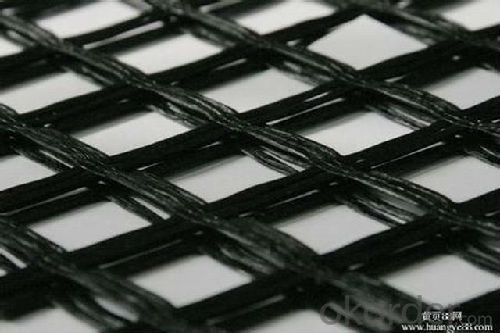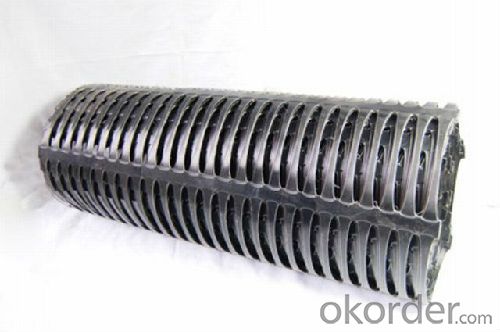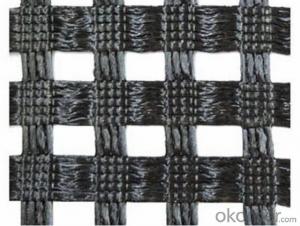Fiberglass Geogrid with CE Certification
- Loading Port:
- Qingdao
- Payment Terms:
- TT or L/C
- Min Order Qty:
- 20000 m²
- Supply Capability:
- 10000000 m²/month
OKorder Service Pledge
OKorder Financial Service
You Might Also Like
Fibergalss Geogrid Profile
Fiberglass geogrid is a new excellent maeterial used for reinforcing road surface and base, it made by fiberglass filament, and covered by special solution. High longitudinal and horizontal strength, low elongation rate, anti-alkali and aging resistance, widely used in asphalt road surface, concrete road surface and reinforceing road base.
Main Features of Fibergalss Geogrid
1.Tensile Strength (KN/m): 30X30KN/M,50x50KN/M,60X60KN/M,70X70KN/M,80X80KN/M
2. Elongation: 3%
3. Mesh Size: 25.4 x 25.4mm or 12.7x 12.7mm
4. Width: 1-6m
5.Temperature Resistance (Centigrade) : -100~290
6.Surface Processing: Modified asphalt or Polymer and self adhesive
7.Packing: with PE bag packing
Also detailed specification may be manufacturered according to your need.
if you are interest in our project, pleas contact me for further information.
Specifications of fiberglass
Specification | 1×1 | 1×1 | 1×1 | 1×1 | 1×1 | 2×2 | 2×2 | |
Strength | Long . Horiz | ≥30 | ≥50 | ≥60 | ≥80 | ≥100 | ≥60 | ≥80 |
≥30 | ≥50 | ≥60 | ≥80 | ≥100 | ≥60 | ≥80 | ||
Percentage of Elongation | 4% | 4% | 4% | 4% | 4% | 4% | 4% | |
Size of Hole mm | 25.4×25.4 | 25.4×25.4 | 25.4×25.4 | 25.4×25.4 | 25.4×25.4 | 12.7×12.7 | 12.7×12.7 | |
Flexibility | 76 | 76 | 76 | 76 | 76 | 76 | 76 | |
Width M | 1--6 | 1--6 | 1--6 | 1--6 | 1--6 | 1--6 | 1--6 | |
Temperature | -100200 | -100200 | -100200 | -100200 | -100200 | -100200 | -100200 | |
FAQ
1.Resistance to Fatigue Cracking of Fiberglass Geogrid
The fiberglass geogrid in asphalt surface can disperse the compressive strength and tensile strength produced when wheels rolled over the pavement. Buffer zone will be formed between two strength areas, and the strength is gradually changed rather than suddenly changed, thus the damage of strength to the asphalt surface is reduced. In the mean time, low elongation rate of the fiberglass geogrid reduced the deflection of the pavement, and protect the pavement from excessive deformations.
2.High Temperature Rutting Resistant of Fiberglass Geogrid
When using fiberglass geogrid in asphalt surface, it acts as skeleton in the surface. Aggregate in the asphalt concrete exists throughout the grid. A composite constraint force in the asphalt surface. The mutual containment of each other in asphalt surface prevents the bed-load of the asphalt surface and resists the effects of rutting.
3.Low temperature shrinkage cracking resistant of Fiberglass Geogrid
In low temperature, asphalt concrete will shrink in cold and tensile strength will be produced. If the tensile strength exceeds the tensile strength of asphalt concrete, it will crack. The application of fiberglass geogrid in asphalt surface, improves the horizontal tensile strength of the surface, and greatly improves the tensile strength of asphalt concrete, thus great tensile strength can be resisted without any damage. In addition, even if some area cracks, the strength in the crack will disappear in their transmission in fiberglass geogrid. Cracks will not develop into fissures.
4.Delay and reduce reflective fissures of Fiberglass Geogrid
Through paving fiberglass geogrid interlayer in the asphalt, the shearing or tensile strength caused by traffic load will be resisted, strain will be released. It will act as tensile improvement material of asphalt concrete, and the purpose to delay and reduce fissures will be achieved.
Product Photos



- Q:How are geogrids manufactured?
- Geogrids are manufactured by extruding or weaving polymer materials such as polypropylene or polyester into a grid-like structure. This process involves melting the polymer, forming it into a grid pattern, and cooling it to create a strong and flexible geogrid.
- Q:How do geogrids improve the performance of geotextile-reinforced embankments?
- Geogrids improve the performance of geotextile-reinforced embankments by providing additional tensile strength and stability. They prevent the lateral spreading of soil and enhance load distribution, reducing the potential for settlement and deformation. Geogrids act as a reinforcement layer, increasing the overall strength and durability of the embankment structure, thereby improving its stability and long-term performance.
- Q:What are the long-term durability characteristics of geogrids?
- Geogrids have excellent long-term durability characteristics. They are typically made from high-strength materials such as polyester or polypropylene, which are resistant to degradation caused by UV exposure, chemical exposure, and biological factors. Geogrids also have high tensile strength, allowing them to withstand heavy loads and maintain their structural integrity over time. Additionally, they have low creep and deformation rates, meaning they can maintain their original shape and performance for an extended period. Overall, geogrids have proven to be highly durable and reliable for various applications in civil engineering and construction.
- Q:How is a geogrid different from other geosynthetics?
- A geogrid is a type of geosynthetic that is specifically designed to provide reinforcement and stabilization to soil and other materials. Unlike other geosynthetics such as geotextiles or geomembranes, which primarily function as filters or barriers, a geogrid is characterized by its grid-like structure that offers high tensile strength and interlocking capabilities. This unique design allows geogrids to distribute loads more efficiently, enhance soil stability, and prevent the lateral spreading of materials.
- Q:How do geogrids enhance the stability of steep highway embankments?
- Geogrids enhance the stability of steep highway embankments by providing reinforcement and confinement to the soil. These grid-like structures are installed within the embankment, creating a stable platform that distributes the load more evenly. This prevents soil erosion, slope failures, and lateral movement, ultimately increasing the overall stability and safety of the embankment.
- Q:What are the design considerations for geogrids in reinforced soil slopes prone to seismic activity?
- The design considerations for geogrids in reinforced soil slopes prone to seismic activity include selecting the appropriate type and strength of geogrids, considering the geometry and layout of the reinforcement, accounting for the dynamic forces and accelerations during seismic events, ensuring proper connection and anchorage of the geogrids to the soil, and conducting thorough stability analyses to assess the safety and performance of the reinforced slope under seismic loading.
- Q:What are the potential drawbacks of using geogrids?
- One potential drawback of using geogrids is the high cost associated with their installation and maintenance. Geogrids are typically made from synthetic materials, which can be expensive to produce and purchase. Additionally, the installation process often requires specialized equipment and skilled labor, further increasing the overall cost. Another drawback is the limited effectiveness of geogrids in certain soil conditions. Geogrids are typically designed to enhance soil stability and reinforce weak or unstable soils. However, in cohesive soils or highly organic soils, geogrids may not provide the desired level of reinforcement. In such cases, alternative solutions or additional measures might be necessary. Moreover, geogrids require proper design and careful installation to ensure their effectiveness. If not installed correctly, geogrids may not perform as intended and could potentially fail. This could result in the need for costly repairs or replacements. Lastly, geogrids may have environmental concerns associated with their production and disposal. Synthetic materials used in geogrids are not biodegradable and may contribute to pollution if not properly managed. Additionally, the manufacturing process of these materials often involves the use of fossil fuels and can generate greenhouse gas emissions. Overall, while geogrids offer numerous benefits in terms of soil reinforcement and stabilization, it is important to consider their drawbacks, including high cost, limited effectiveness in certain soil conditions, installation requirements, and potential environmental impacts.
- Q:Can geogrids be used in temporary retaining walls?
- Yes, geogrids can be used in temporary retaining walls. Geogrids are commonly used in retaining walls to provide stability and reinforcement to the structure. They can be particularly useful in temporary retaining walls as they offer strong tensile strength and prevent soil erosion, ensuring the wall remains stable during its intended lifespan.
- Q:Are geogrids suitable for use in bridge approaches?
- Yes, geogrids are suitable for use in bridge approaches. Geogrids provide soil stabilization and reinforcement, which is crucial in bridge approaches where the soil needs to withstand heavy loads and potential settling. They improve the overall strength and stability of the soil, preventing erosion and increasing the lifespan of the bridge approach.
- Q:What are the factors that affect the installation cost of geogrids?
- There are several factors that can affect the installation cost of geogrids. These factors include the size and complexity of the project, the type and quality of the geogrid material, the site conditions such as soil type and slope stability, the availability and accessibility of the site, and the labor and equipment required for installation. Additionally, factors such as transportation costs, permits, and any necessary site preparation or excavation work can also impact the overall installation cost of geogrids.
1. Manufacturer Overview |
|
|---|---|
| Location | Shandong, China |
| Year Established | 2002 |
| Annual Output Value | Above US$ 20 Million |
| Main Markets | 20.00% North America 15.00% South America 15.00% Eastern Europe 10.00% Southeast Asia 10.00% Northern Europe 10.00% South Asia 10.00% Western Europe 5.00% Africa 5.00% Mid East |
| Company Certifications | ISO9001:2000; |
2. Manufacturer Certificates |
|
|---|---|
| a) Certification Name | |
| Range | |
| Reference | |
| Validity Period | |
3. Manufacturer Capability |
|
|---|---|
| a)Trade Capacity | |
| Nearest Port | Qingdao Port |
| Export Percentage | 41% - 50% |
| No.of Employees in Trade Department | 6-10 People |
| Language Spoken: | English; Chinese; |
| b)Factory Information | |
| Factory Size: | Above 80,000 square meters |
| No. of Production Lines | Above 10 |
| Contract Manufacturing | Design Service Offered; Buyer Label Offered |
| Product Price Range | High; Average |
Send your message to us
Fiberglass Geogrid with CE Certification
- Loading Port:
- Qingdao
- Payment Terms:
- TT or L/C
- Min Order Qty:
- 20000 m²
- Supply Capability:
- 10000000 m²/month
OKorder Service Pledge
OKorder Financial Service
Similar products
New products
Hot products
Hot Searches
Related keywords































